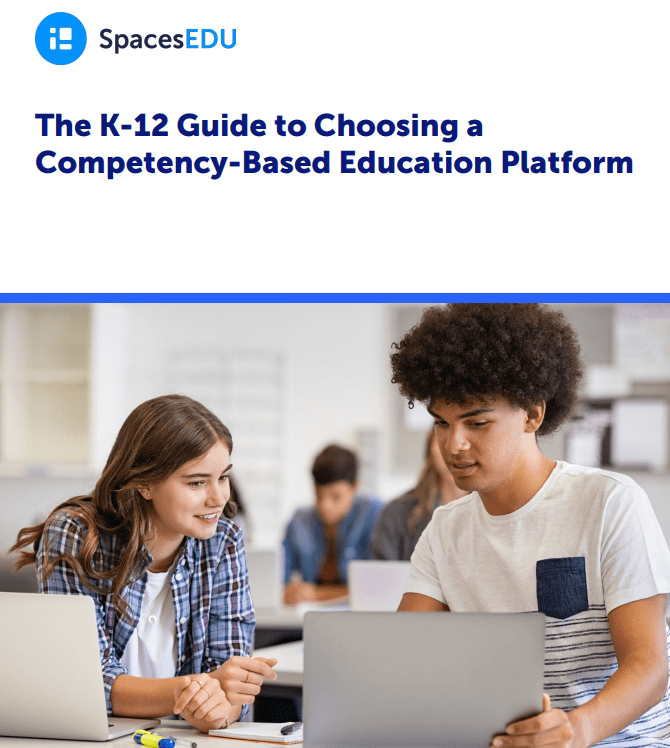As the world continues to change, so too does education. In recent years, we’ve seen a shift to a more student-centric approach to K–12 education, with many school districts leaning into competency-based education and standards-based grading (SBG). This blog provides a comprehensive overview of why K–12 school districts are embracing SBG, including the benefits of standards-based grading and real-world examples.
From Traditional to a Standards-Based Grading Model
With the shift towards standards-based grading and every state now allowing students to be measured based on mastery, it begs the question: what is it about traditional grading systems that have sparked this shift?
Traditional numerical or alphabetical grading models, while familiar and easy to track, often fail to capture the depth of a student’s understanding, focusing more on performance than on the acquisition of knowledge. In an era of education that demands adaptability and a focus on individual student needs, a standards-based grading system is a viable solution to address the shortcomings of the traditional education system and grading models.
What is Standards-Based Grading?
Fundamentally, standards-based grading refers to assessing students based on their mastery of a specific learning objective or standard. Rather than emphasizing points and percentages, this approach focuses on demonstrating a level of proficiency in essential skills and knowledge.
With standards-based grading systems, come additional benefits that are lacking in traditional grading models including student-centered personalized learning, student agency, increased student engagement and motivation, and equity.
Standards-Based Education and Student Agency
With a standards-based or mastery-based learning model, there is increased student agency. Learners are given greater autonomy to take control of their journey through voice and choice, as they must demonstrate mastery of a skill, before moving on to the next one. Alongside student agency, comes benefits to student motivation. When students are aware of expectations, and see the direct correlation between their effort and growth, they’re more likely to be engaged in their learning.
Listen: Growth Over Grades | S2E6 | Dr. James Neihof | Competency-Based Education and Student Agency
Competency-Based Education (CBE) Leads to Personalized Learning
By aligning assessments with specific standards, educators can easily see which areas a student is excelling in, and where they may need additional support. It provides a more accurate representation of a student’s understanding of a concept and makes it easier to provide additional, targeted support in a more personalized way. With a competency-based learning model and tools like digital portfolios, educators can tailor their instruction to each student – making for a more student-centric, personalized learning experience.
Mastery-Based Education Promotes Equity
With mastery-based education systems, there’s the potential to promote greater equity in education. Traditional grading fails to consider diverse learning needs and that students start their learning journey with a wealth of different experiences, skills, and starting points. By design, standards-based grading allows for a more diverse range of authentic assessment methods. These assessments allow students to showcase their understanding in a way that speaks to them – providing a more inclusive approach to evaluation, and ensuring students can play to their strengths when demonstrating mastery. With mastery-based learning, the emphasis is on mastery of specific standards, ensuring that success is attainable for all learners and that grades are not the sole focus of success.
Working Towards Competency-Based Education
Deeper Learning in Kentucky
In the state of Kentucky, a lot of work has been done to move towards competency-based education. In fact, Kentucky was the first state to work towards a state-wide reform and has had teachers and school leaders come together to develop a standards-based report card. At the Department of Education level, there are deeper learning and competency-based education initiatives through United We Learn. United We Learn is Kentucky’s vision for the future of education and aims to create deep, authentic learning experiences for students. Within this vision, Kentucky developed a Portrait of a Learner to reference the competencies and skills all learners should demonstrate when they leave school.
Looking for ways to support K-12 student career readiness? Access key strategies from a panel of college and career-readiness experts.
Competency-Based Learning in New Hampshire
The New Hampshire Department of Education alongside the New Hampshire Learning Initiative has been focused on competency-based learning for quite some with initiatives like the Performance Assessment of Competency Education (PACE) and their No Grades, No Grades (NG2) pilot program both aimed at deepening personalized, competency-based learning. learning and competency-based education within the state. With the N2G program, New Hampshire elementary and middle schools focused on more flexible learning pathways, with multi-age grade bands and the elimination of traditional grading. The six tenets of this program included project-based learning, learner agency, whole-child development, blended learning, and competency-based assessment. NG2 schools have moved away from using the term grades, and have experienced positive outcomes, including increased student learning and more personalized learning experiences.
Mastery-Based Learning(MBL) in Washington
In Washington state, the mastery-based learning work group came together to transform their education system and close opportunity and achievement gaps through MBL and culturally responsive-sustaining education (CRSE). In their 2020 report, they share the barriers to mastery-based learning in the state and recommendations around how to implement and increase capacity for MBL. While the state is just concluding its second year of MBL, the Mastery-Based Learning Collaborative reported that educators and school leaders were feeling more prepared for deeper implementation, and observed significant and successful shifts within schools. Going into year 3, the focus continues to be on deeper implementation, continued professional learning, and state- and school-level policy refinement.
There are numerous benefits to standards-based grading and the adoption of SBG represents a significant shift towards more student-centered learning. As more states move toward CBE, it’s crucial to understand the underlying philosophy and benefits associated with this approach. By embracing competency-based education and standards-based grading, school districts are able to foster improved student agency, motivation, and educational equity.
Looking to implement CBE in your district? Download this free guide to choosing a competency-based education and SBG platform.


